Sexual and Reproductive Health in Adolescence
Unidad de Apoyo para el Aprendizaje
Proyecto PAPIME Clave: PE308817
StartThere are several challenges that the teenager has to overcome to move from one stage to another, among which are:

Pxhere. 2017. Adolescent [photo]. Retrieved from: https://pxhere.com/es/photo/934872
During the various phases of this growing stage, adolescents undergo a series of cognitive, sexual and moral changes, which have an impact on each other and are influenced by physical development that will allow them to progressively achieve tasks in decision-making, abstract thinking, and also in the management of their freedom, the responsibility in their actions and a fully healthy sexuality (Gaete, 2015).
In this unit, you will be able to learn about some determinants and characteristics of this important stage. The first information is a demographic framework with statistical data and a social point of view so that you can review hard data about this population.
Later, through a sociocultural context, you can recognize how each culture characterizes and relates the changes that occur during this process and places the adolescent according to their own demands. Then, certain biological determinants will give you the opportunity to relate the changes that occur at the organic level, with the indefinable critical behavior of adolescence. Finally, but not least, you are presented with the influence of the previous aspects on the repercussion within the decision-making, particularly on pregnancy.
Adolescence is one of the most difficult stages for young people, since it consists of physical, social and cultural determinants, according to the person and its context. So, you can identify what you know about this important biological stage, complete the following statements.
As is well known, Mexico is a country with a large young population. This segment is between 15 and 29 years old and constitutes an important social, economic, political and cultural force at the national level. Based on the following statistics, it is possible to affirm that the adolescent generation must be a reference for social health and care policies:
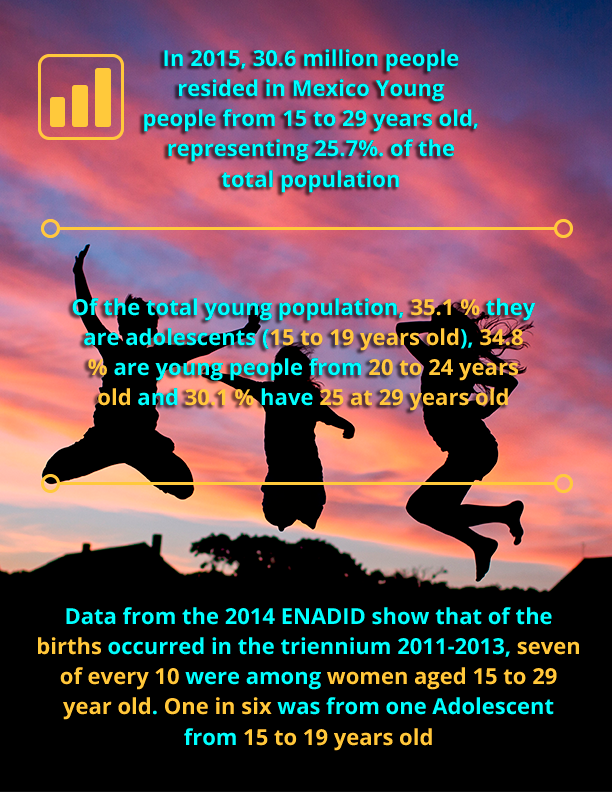
Inegi. (2018). Estadísticas a propósito del… día internacional de la juventud (12 de agosto) (15-29 años) [imagen]. Retrieved from: https://www.inegi.org.mx/contenidos/saladeprensa/aproposito/2018/juventud2018_Nal.pdf
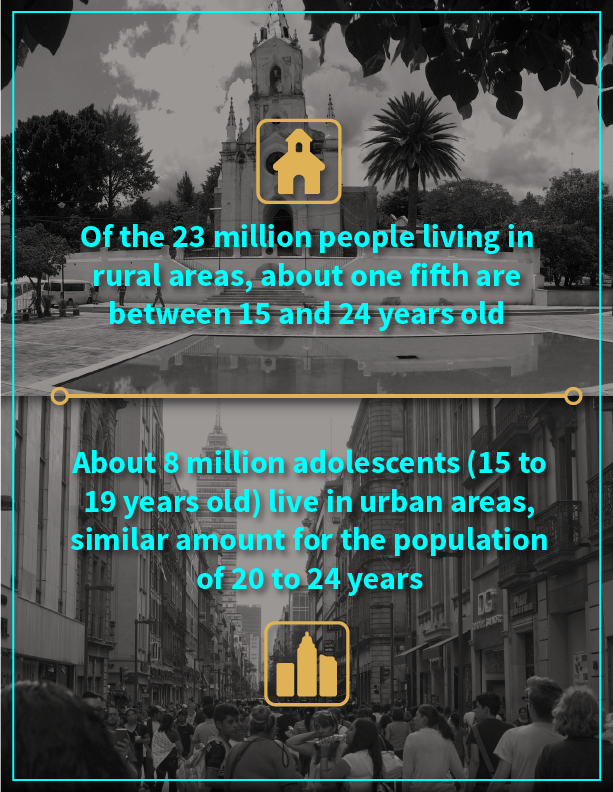
Inegi. (2018). Estadísticas a propósito del… día internacional de la juventud (12 de agosto) (15-29 años) [imagen]. Retrieved from: https://www.inegi.org.mx/contenidos/saladeprensa/aproposito/2018/juventud2018_Nal.pdf

Pixabay. (Aug.30.2017). Rainbow Girl [photo]. Retrieved form: https://pixabay.com/photos/girl-face-colorful-colors-artistic-2696947/
The largest number of young people in the national territory has been registered; however, its relative weight in the total population and has begun to decrease since the last two decades, during the present decade the use of contraceptives in women of childbearing age has increased, which translates into the right Constitution to decide on the number of children (Conepo, 2016).
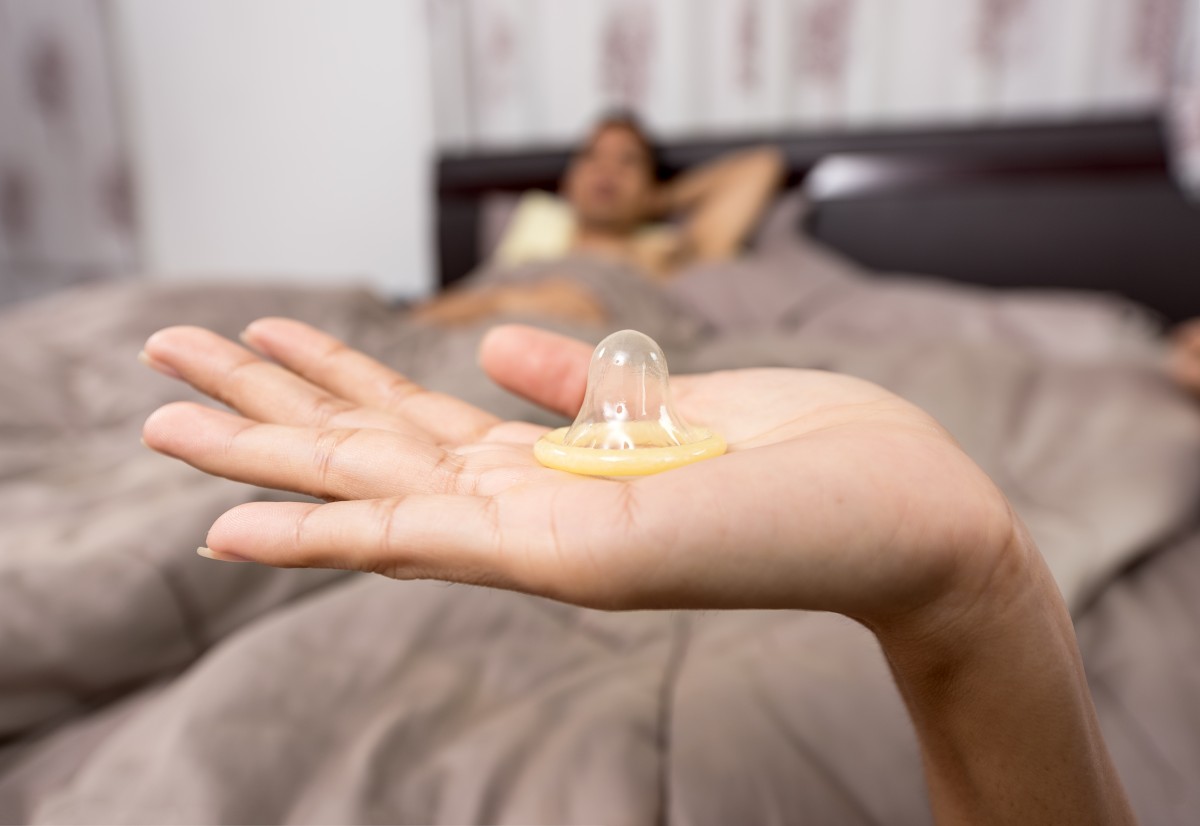
(n. a.) (2017). Use of contraceptives [photograph]. Retrieved from: https://pxhere.com/es/photo/1271250
It is important to consider factors that have influenced the youth population in a contemporary context, such as:
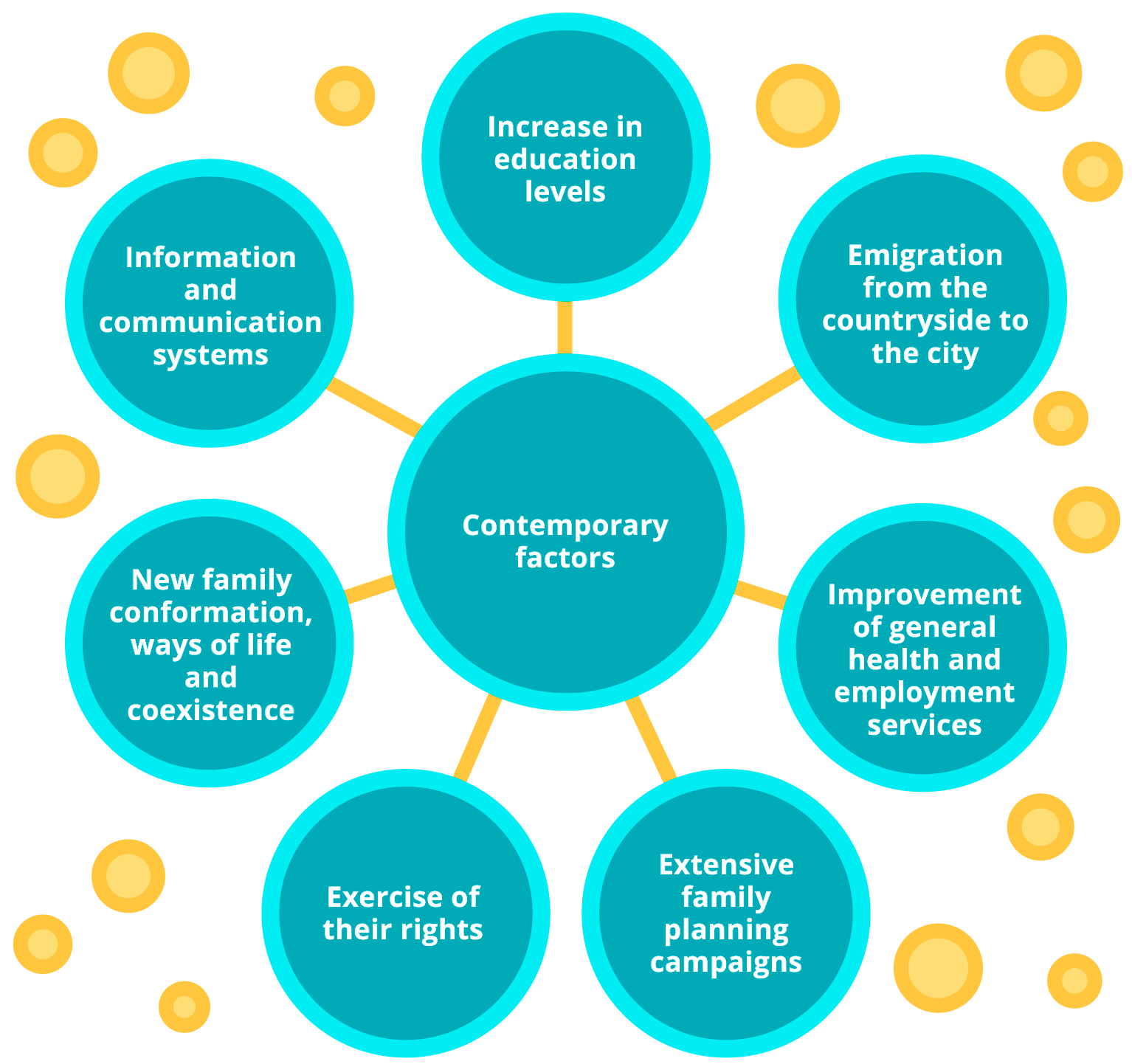
The young ones are those who, in a responsible way, will contribute to a future life project.
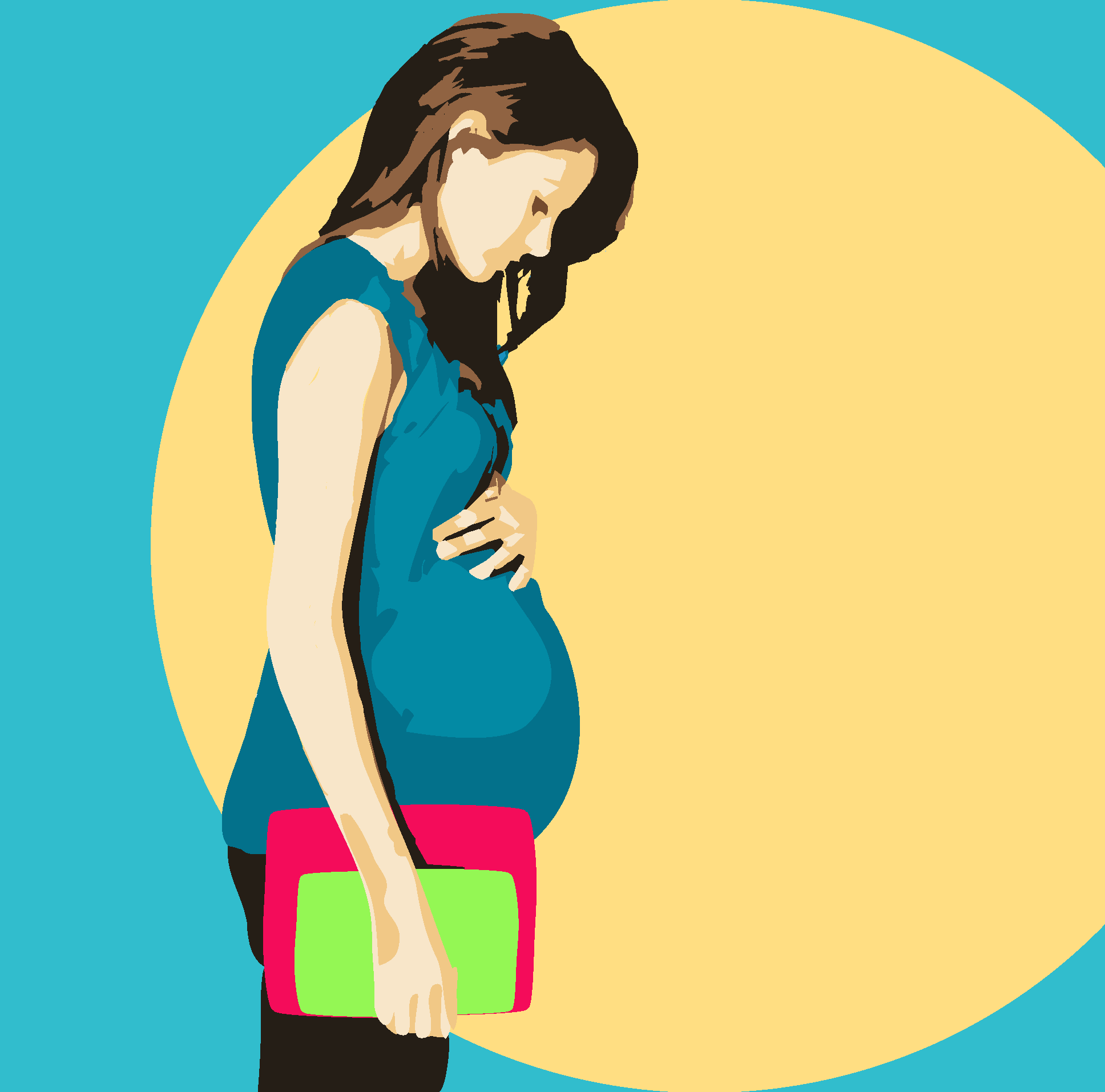
The adolescent is at the center of a highly complex and difficult process: his sociocultural characteristics are linked to the rapid biological and psychological changes of the person and the speed at which cultures and societies are transformed.
It is important to mention that today's society imposes the young person's need to accept moral and ethical values not only to guarantee society and its culture, but also its growth and development. In contrast, the market marks, in general, the population for the sake of production and consumption. For this reason, the hope of a more just and humane society must envision young people with the necessary potential.
Click on each arrow to identify the differences of adolescence in two historical periods.
The social context and the cultural possibilities of young people define their opportunities and risks. The use of its potential is a principle of participation and development of the young person's self-esteem. In the video Adolescents in society, you can recognize some of the risks involved in the sociocultural context.
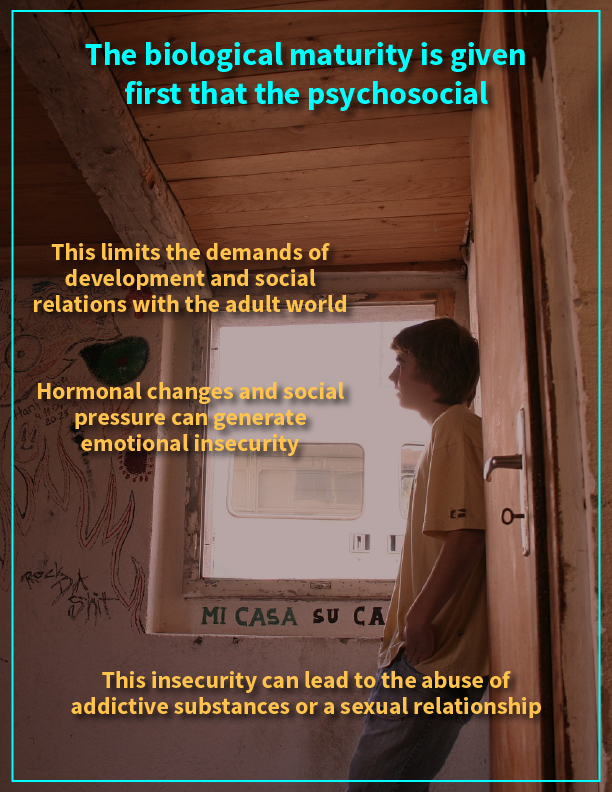
Pxhere. (2017). Emotional insecurity [photo]. Retrieved on may 2018: https://pxhere.com/es/photo/937833
In adolescence, reproductive capacity is acquired, characterized by the first physical manifestations that generate the change from childhood to adulthood. First, they become evident through changes in physiological structure.
During this evolutionary stage, the changes that allow the adolescent to have a new perception of the world and with ways to face the daily problems that demand to live with an independent thought, prepare him for the rational decision making. In addition, the formation of the adolescent's psychosexual identity is based on these physical changes and is complemented by the intervention of several social determinants that, together, seek the integration of all these characteristics that define the personality of the adolescent, which allows him to play a sexuality within a social framework and according to their life goals.

Pxhere. (2017). Teen couple [photo]. Retrieved from: https://pxhere.com/es/photo/1071679
Different authors define adolescence as:

Physical changes occur in stages called early, middle and late adolescence, each with characteristics.
Click on each stage to recognize its characteristics.
Knowing the physical changes of adolescence allows us to be aware of this critical stage, which will conclude in a healthy adulthood.
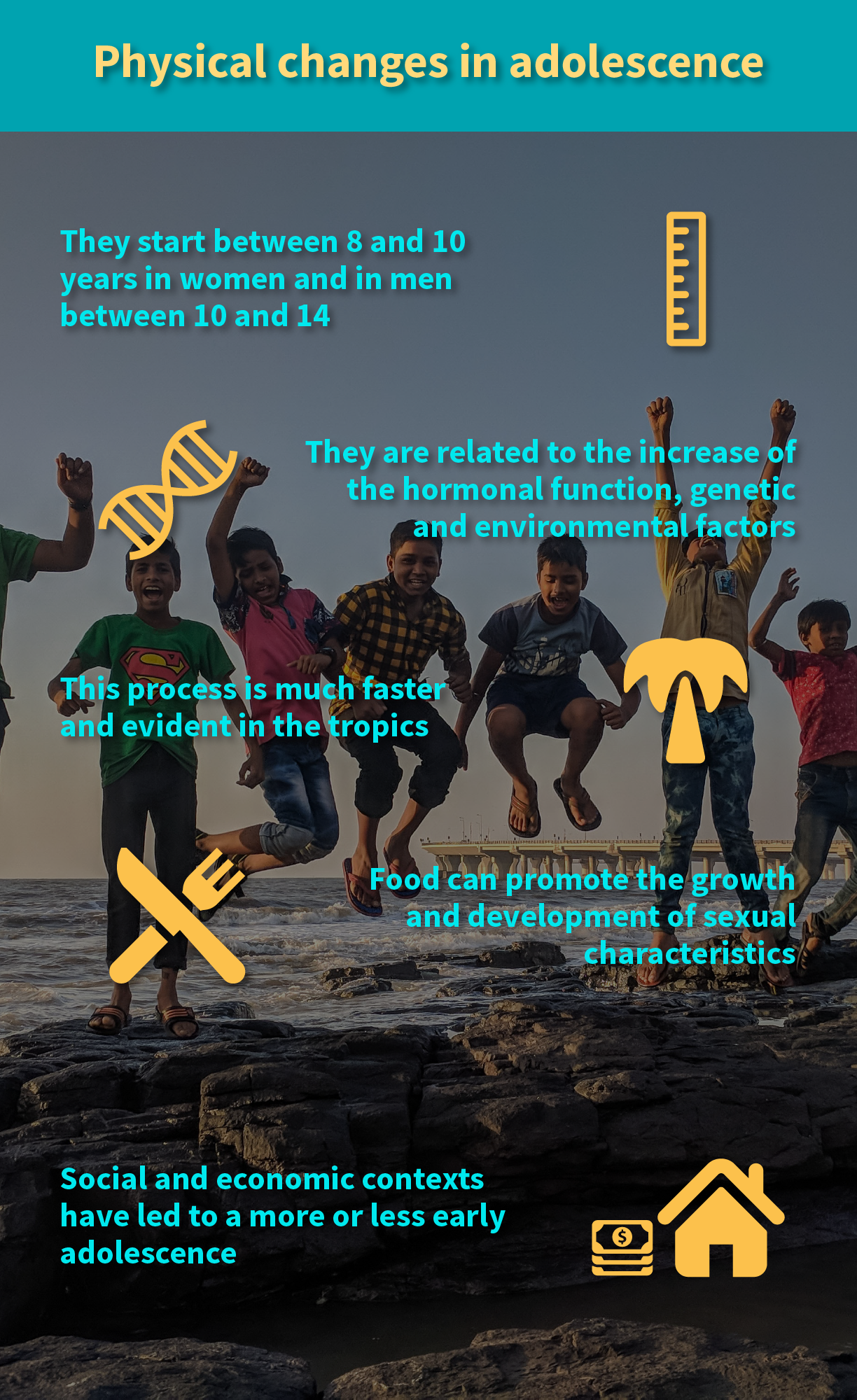
In this way, both the factors of inheritance and those of social and environmental order are combined in the determination and expression of physical development and sexual maturity. At present, there is a long process of preparation that goes from 10 to 19 years to be able to be self-sufficient in all senses. By gender, physical changes manifest as follows:
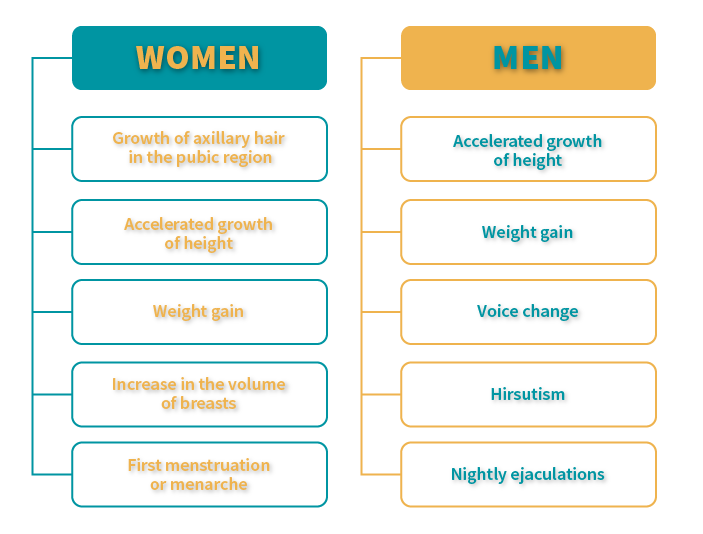
During adolescence, the growth, in general, of the skeletal and muscular elements accelerates. This constitutes the increase in height, which is more noticeable as the hormonal changes take place. Due to hormonal changes, body fat is redistributed characteristically in women and men, which is called secondary sexual characteristics. The redistribution of fat and the increase in height translate into greater body weight:
Click on to identify the adolescent weight scale in men and women.
Sexual maturation occurs due to the effect of female and male hormones and is characterized by the establishment of menstrual cycles in women and spermatogenesis in men. For its evaluation, the Tanner scale is used, which serves as support to determine the degree of sexual maturity in adolescents and contemplates primary and secondary external changes, for example, the distribution of pubic and axillary hair, growth of the breasts and genitals.
Click on to identify the Tanner scale
The biological, psychological and social changes of adolescence should be a reference of preventive and anticipatory risks, without forgetting that each adolescent is a singularity towards which the process of unique, unrepeatable and complex care is directed.
Click on to recognize some consequences of teenage pregnancy.
To deepen on the issue of adolescent pregnancy and its repercussions, we recommend you review the "Situation of human rights in women" published by the CNDH.
Recognizing the changes of adolescence allows you to have acceptance and identity, necessary in the evolution of the human being in this society. Changes include those of a physical, emotional and social nature, but there is a relationship between them that determines the young.
During adolescence, important biological and psychosocial changes occur that establish the goals of their adulthood.
Information sources
Bibliography
Díaz, J. (1993). La instrucción pública en México. Ciudad de México: Porrúa.
Jefrey, A. (2008). Adolescencia y adultez emergente; un enfoque integral (3.ª edición). Estado de México: Pearson.
Electronic documents
Consejo Nacional de Población (Conepo). (2016). Principales indicadores de salud sexual de las mujeres en edad fértil unidas (MEFU) y de las mujeres en edad fértil sexualmente activas (MEFSA) del país y de las 32 entidades federativas. Gob. mx. Consulted on april 17th 2018 from: https://www.gob.mx/conapo/acciones-y-programas/salud-sexual-y-reproductiva
Fondo de las Naciones Unidas para la Infancia (Unicef). (2011). Estado mundial de la infancia 2011. La adolescencia: Una etapa de oportunidades. Nueva York: Autor. Retrieved (17-04-2018) from: https://www.unicef.org/honduras/Estado_mundial_infancia_2011.pdf
Gaete, V. (2015). Desarrollo psicosocial del adolescente. Sociedad Chilena de Pediatría, 86(6), 436-443. Retrieved (17-04-2018) from: https://www.sciencedirect.com/science/article/pii/S0370410615001412
Hernández, D. (n. d.). La instrucción pública en la reconstrucción de la república (1867-1876).Facultad de Ciencias Políticas y Sociales-UNAM. Retrieved (17-04-2018) from: https://www2.politicas.unam.mx/sae/wp-content/uploads/2014/09/IPReconstruccionDeLaRepublica.pdf
Instituto Nacional de Estadística y Geografía (Inegi). (2016). Estadísticas a propósito del Día Internacional de la Juventud (15-29 años). Retrieved (17-04-2018) from: http://www.beta.inegi.org.mx/contenidos/saladeprensa/aproposito/2018/juventud2018_Nal.pdf
Electronic documents
Bully Magnets. (11-01-2018). Adolescents in society [Video file]. Retrieved from: https://www.youtube.com/watch?v=wIqOVpQ0j08
Comisión Nacional de Derechos Humanos del Distrito Federal (CDHDF). (2016). Embarazo en adolescentes y el ejercicio de los derechos sexuales y reproductivos en la Ciudad de México. Situación de los derechos humanos en las mujeres. Ciudad de México: Autor. Retrieved (12-06-2018) from: https://cdhdf.org.mx/wp-content/uploads/2015/06/embarazo.pdf
Organización Panamericana de la Salud (OPS). (2013). Un modelo para des-armar: Tres caminos, una vida. La travesía de la adolescencia. ¿Qué es la adolescencia? Campus Virtual de Salud Pública. Retrieved (12-06-2018) from: http://www1.paho.org/CDMEDIA/FCHCOURSE/espanol/
How to quote
Pérez, Í., Hernández, J. y Tapia, B. (2019). Sexual and reproductive health in adolescence. Unidades de Apoyo para el Aprendizaje. CUAED/ENEO-UNAM. Retrieved on (date) from (link)